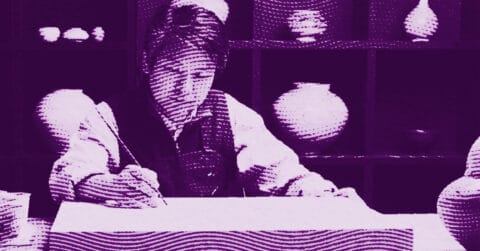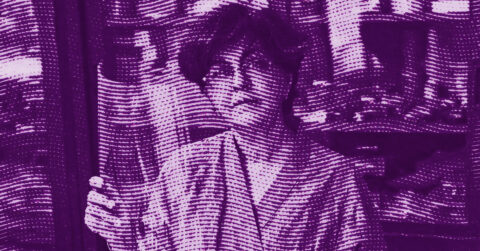Listen to me carefully, you bunch of snobs. You are there, with your lukewarm champagne glasses and your overwrought comments on contemporary art, pretending to understand what is happening before your eyes. But have you really seen Toyin Ojih Odutola? Not simply glanced at her works in passing, but plunged into the deep layers of her drawings, where skin becomes a map of a visceral experience you can only touch lightly?
Toyin Ojih Odutola’s work is an act of resistance against narrative simplifications. This Nigerian-American artist, with her ballpoint pens, pastels, and charcoal, creates much more than portraits; she forges bodily landscapes that tell alternative stories, parallel worlds where black protagonists escape the constraints of colonial history. She transforms black skin into a sumptuous territory of infinite possibilities.
What immediately strikes one is her meticulous layering technique. Every square centimeter of skin in her drawings contains a universe of deliberate marks, undulating textures that seem to pulse under your gaze. This approach inevitably recalls Édouard Glissant’s philosophy and his concept of a “poetics of Relation” [1]. Glissant speaks of identity as a rhizome, a system of multiple interconnected roots rather than a single dominant root. He rejects identity as a fixed essence and embraces identity as relation, as a dynamic process of encounters and exchanges.
Isn’t this exactly what Ojih Odutola does? Her technique of layered surfaces evokes this rhizomatic vision of identity. She creates characters whose skin is a crossroads of stories, influences, and possible futures. “I read marking as a form of language,” she says, “in the same way one might read English.” [2] The marks on the skin are not mere aesthetic features, but a complex semiotic system that narrates experiences of displacement, migration, and identity recomposition.
In her exhibition “To Wander Determined” at the Whitney Museum, Ojih Odutola created a series of fictional portraits recounting the story of two Nigerian aristocratic families united by the marriage of two men. This speculative fiction is a bold political gesture that transforms the postcolonial imagination. By envisioning an alternative Nigeria where homosexuality is not criminalized, where Black wealth is normalized and celebrated, she does not merely represent “what is” but explores “what could be.”
This approach echoes the speculative literature of Octavia Butler, whose signature Ojih Odutola bears tattooed on her left hand. Butler and Ojih Odutola share this capacity to use fiction as a laboratory for social experimentation, to interrogate and reconfigure power structures. As Butler writes in “Parable of the Sower”: “Everything you touch, you change. Everything you change changes you.” [3] The creative act thus becomes an act of transformation both personal and collective.
The power of Ojih Odutola’s work lies precisely in this ability to make us imagine other possible worlds, other social configurations. By placing her Black characters in contexts of power, leisure, and intimacy rarely depicted in Western art, she expands the horizon of possibilities. Her protagonists are not defined by their suffering or resistance to oppression but fully exist in their complex individuality.
Take “The Firmament” (2018), this masterful work where a dark-skinned character stands out against a deep blue background. The richness of the skin texture, with its luminous streaks and velvety shadows, transcends simple biological representation to become cosmic. The skin is no longer just a bodily envelope but a starry sky, a firmament. This transformation of the body into cosmos recalls Maurice Merleau-Ponty’s phenomenological approach, for whom the body is our “anchor in the world,” the zero point of all perception and experience [4].
In “A Countervailing Theory” (2020), her first solo exhibition in the United Kingdom, Ojih Odutola pushes her narrative exploration even further. She invents a prehistoric matriarchal civilization on the Jos Plateau in Nigeria, where a ruling class of warrior women enslaves artificially created men. This inversion of gender and power relations confronts us with our most deeply ingrained assumptions about the “natural order” of things.
Through this alternative mythology, Ojih Odutola not only questions gendered domination structures but also the narrative archetypes that shape our understanding of history. She thus reveals that what we consider “natural” or “inevitable” is often only a contingent construction, one narrative among other possibilities. This decolonial approach attacks the epistemic foundations of Western domination.
Her technique of black and white drawing in this series accentuates the archaeological nature of her approach, as if she were unearthing remnants of a forgotten history. The circular composition of the exhibition at the Barbican, where the viewer follows a curved path without ever seeing the entire story at a single glance, reinforces this impression of progressive discovery, of a narrative that unfolds step by step.
But it is perhaps in her series “The Treatment” (2015-2016) that Ojih Odutola takes her reflection on the mechanisms of racial construction the furthest. By representing famous white male figures with black skin, she exposes whiteness as a social construct rather than a biological fact. If a Picasso or a Prince Charles can be depicted with black skin without affecting their recognition, it is precisely because race is above all a system of culturally encoded signs and values.
Let us return to Glissant and his distinction between “system thinking” and “trace thinking.” The former seeks to categorize everything, to fix everything into stable and separate identities. The latter accepts the unpredictable, the opaque, the perpetual movement of identities. Ojih Odutola’s work is firmly rooted in this trace thinking: it blurs boundaries, complicates identities, celebrates opacity as a fundamental right not to be fully understood or categorized.
“I am not concerned with documenting my daily life as it is,” the artist declares, “but with vignettes of things, moments, memories, things that don’t quite make sense, but are not necessarily surreal. There is reality in my work, but this reality is a scaffold for the imaginary to emerge, proliferate, and circulate.” [5] This statement could just as well come from Glissant himself, who defends the right to opacity against the universalizing claims of Western transparency.
In her more recent series, “Tell Me A Story, I Don’t Care If It’s True” (2020), created during the lockdown in New York, Ojih Odutola juxtaposes text and image to explore the multiple truths that can coexist within a single narrative. This series echoes the theories of the philosopher Jean-François Lyotard on the end of grand narratives and the emergence of multiple and contradictory micro-narratives [6]. At a time characterized by “alternative facts” and ideological polarization, this reflection on the ambiguous nature of narrative truth takes on a particular resonance.
Ojih Odutola’s art is also deeply theatrical. Her characters seem aware of being observed but refuse to perform for the external gaze. They exist in a state of deliberate nonchalance that decentered the viewer. Even when they face the observer, they appear to look beyond, toward a horizon we cannot perceive. This resistance to the colonizing gaze recalls Sartrean phenomenology and its conception of the gaze of the other as potentially objectifying [7].
In “Chosen” (2020), two characters contemplate a display window labeled “SALE.” One adjusts her lip gloss while a conversation about self-esteem unfolds. “Don’t worry, if we had a choice, we would not choose ourselves,” says one. “Well… I would choose you,” replies the other. This seemingly ordinary scene condenses the entire complexity of intersubjective relationships in a capitalist and post-colonial context where black bodies are constantly commodified.
What fundamentally distinguishes Ojih Odutola from many contemporary artists is her categorical refusal of pathos and trauma as the only modes of representing black bodies. She insists on joy, contemplation, rest as experiences that are just as political and meaningful as suffering or resistance. In an artistic landscape where black pain is often spectacularized and commercialized, this celebration of quiet and leisure constitutes a radical act.
As she explains herself: “What happens if you claim every place you go to as a home? Some black people avoid traveling because they reasonably fear encountering racism. I wanted to help ease this hesitation by portraying black people outdoors, in nature, swimming in lagoons, relaxing on the beach, admiring the sunset.” [8] This normalization of black presence in spaces of leisure and contemplation is deeply political in its very banality.
Ojih Odutola’s approach is reminiscent of Toni Morrison’s, who stated that she wanted to write the books she would have liked to read. The artist creates images she would have liked to see as a child, representations where black people fully exist in their complex humanity, their beauty, and their everyday ordinariness. “The work I am doing now is the work my nine-year-old self imagined,” she says, “just as previous work was what my five-year-old self conjured.” [9]
This connection to childhood is no coincidence. It is precisely in childhood that our first imaginaries, our first visions of possibility, are formed. By creating alternative worlds where black people naturally occupy positions of power, leisure, and intimacy, Ojih Odutola expands the horizon of possibilities for future generations. She offers what feminist theorist bell hooks would call “spaces of agency,” representations that allow one to imagine oneself as an actor rather than a mere object of others’ gaze [10].
The strength of her work also lies in its balance between the intimate and the political, between the personal and the collective. Her portraits, though fictional, possess such presence, such vitality that they seem to breathe before our eyes. This ability to infuse life into her paper characters testifies not only to exceptional technical mastery but also to profound empathy.
For despite all its conceptual sophistication, Ojih Odutola’s art remains deeply human. It touches us not because it explains a theory, but because it makes us feel an experience. The texture of her drawn skin becomes a metaphor for a layered existence, complex, rich with contradictions and possibilities.
In an artistic world still too often structured around the white, male, Western gaze, Toyin Ojih Odutola offers us a radically different vision, where black skin is no longer a stigma but a cosmos, where identity is no longer a cage but a playground. She broadens our conception of the possible, pushes the boundaries of the imaginable, and reminds us that every dominant narrative can be contested, subverted, reinvented.
So, you bunch of snobs, the next time you gaze upon a work by Ojih Odutola, perhaps you will see beyond her technical virtuosity, perhaps you will feel this invitation to inhabit the world differently, to imagine other possibilities. And if not, well, content yourselves with your lukewarm champagne and tasteless conversations. Ojih Odutola’s art will continue to exist, to breathe, and to transform the world, with or without your understanding.
- Édouard Glissant, Poetics of Relation, Gallimard, 1990.
- Kristin Farr, “Toyin Ojih Odutola, Infinite Possibility”, Juxtapoz, September-October 2017.
- Octavia Butler, Parable of the Sower, Four Walls Eight Windows, 1993.
- Maurice Merleau-Ponty, Phenomenology of Perception, Gallimard, 1976.
- Kristin Farr, “Toyin Ojih Odutola, Infinite Possibility”, Juxtapoz, September-October 2017.
- Jean-François Lyotard, The Postmodern Condition, Éditions de Minuit, 1979.
- Jean-Paul Sartre, Being and Nothingness, Gallimard, 1943.
- Jackie Mantey, “Art you should know: Painter Toyin Ojih Odutola”, May 22, 2018.
- Kristin Farr, “Toyin Ojih Odutola, Infinite Possibility”, Juxtapoz, September-October 2017.
- bell hooks (Gloria Jean Watkins), Black Looks: Race and Representation, South End Press, 1992.
















